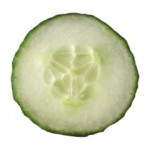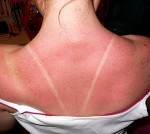Sun Burn Remedy
A combination of common kitchen ingredients and some TLC will help soothe the pain and discomfort of sore sunburned skin.
To help set your treatment goals, you first need to understand WHY sunburned skin is red and tender.
A sunburn results from a cascade of inflammation in your skin, all of which was triggered by excessive sun exposure. There is no “cure” for a sunburn, it simply has to run its course. You can, however, soothe inflammation to make your skin more comfortable. You can’t reverse the skin DNA damage that resulted from excessive sun exposure though.
What are the best natural remedies to speed skin healing and soothe sunburn pain?
 The best natural sunburn remedy is cool pure aloe vera juice or a cool paste made of cucumbers, or a combination of the two.
The best natural sunburn remedy is cool pure aloe vera juice or a cool paste made of cucumbers, or a combination of the two.
Pure aloe vera gel or juice from the plant soothes inflamed skin and is a good home remedy for burns. Apply cool pure aloe vera gel to sunburned skin to help relieve discomfort and inflammation. Never use an aloe vera gel product that contains topical anesthetic ingredient, such as benzocaine or lidocaine, because they can cause an allergic skin rash that will make your skin both hurt and itch at the same time.
 Cucumbers are rich in natural botanical compounds that have both antioxidant and analgesic properties. The best way for using cucumbers on sunburned skin is to make a paste of chilled cucumber. Chill your cucumbers, then use your kitchen blender to create a paste. Apply the paste to sunburned skin to help soothe sunburn pain and inflammation naturally.
Cucumbers are rich in natural botanical compounds that have both antioxidant and analgesic properties. The best way for using cucumbers on sunburned skin is to make a paste of chilled cucumber. Chill your cucumbers, then use your kitchen blender to create a paste. Apply the paste to sunburned skin to help soothe sunburn pain and inflammation naturally.
You can add some of the aloe vera juice or gel to your cucumber paste to combine the healing properties of both. Remember to use cool gel or paste as the coolness also speeds recovery by constricting your skin’s capillaries, which are bringing in the building blocks of pain and inflammation.
Is it good to put ice packs on your sunburn?
Gently cooling the skin is helpful, but the direct application of ice isn’t gentle. As I mentioned above, cooling causes your skin’s capillaries to constrict. When skin is red, like when it’s sunburned, the skin capillaries are “wide open” and flowing with blood circulation to bring in building blocks of inflammation. When capillaries are constricted, these building blocks aren’t so easily delivered to the skin and inflammation is lessened.
For inflamed skin in general, dermatologists usually recommend cool soaks with a cool, wet towel, but putting a towel over a bag of frozen peas or ice pack is another idea. The idea is to gently cool your skin, so don’t apply the ice pack directly to your injured skin, it would be too harsh. Instead, use a thin towel to separate the ice pack and your sunburned skin.
Should you avoid getting hot water on a sunburn?
Relying on the same principles that make cool water helpful, you should avoid exposing sunburned skin to hot water. Hot water opens up the skin’s capillaries, increasing blood flow which then brings in the building blocks of inflammation. This will create even redder and more inflamed skin. Plus, sunburned skin hurts when you expose it to hot water.
What other TLC do you need to heal your sunburn fast?
You need to baby your sunburned skin because it’s more vulnerable to irritation than normal skin. Its barrier strength is damaged because the cell layers are swollen. Even if you don’t have visible blisters, you have swelling and microscopic edema (little microscopic blisters) under your skin which weaken your skin barrier. Your skin cells are also more vulnerable than normal because there will be some loss of their protective outer dead skin cell layer as the sunburned skin starts peeling.
The bottom line: your skin is porous and fragile and needs to be “babied,” which means:
- Don’t excessively rub, peel, or expose sunburned skin to harsh products such as acne medicines, alpha hydroxy acid anti-aging products (glycolic acid), retinol or tretinoin (Retin A or Renova), harsh soaps, or chemicals. You’ll notice that if you do, your skin will sting.
- Don’t re-expose sunburned skin to the sun until it is entirely healed. This is because the outer protective dead skin cell layer is damaged, so more harmful UV rays will pass into it, and you’ll get a sunburn even more quickly and this whole story starts over again.
If you don’t baby your sunburned skin and give it lots of TLC then you’re just compounding the injury – you’ll have more redness and more discomfort and it will take longer to heal.
BUT, the best treatment for a sunburn is prevention!
5 Simple Tips to Prevent A Sunburn
- Avoid sunburns all together by wearing the right sunscreen for your activities. I recommend zinc oxide products for the protection I trust the most. Modern zinc oxide sunscreens are easy to use and they rub in clear or almost clear. They are the natural “mineral” sunscreens and there are some excellent natural zinc oxide sunscreens made with organic and botanical ingredients. This means you can use green and natural skin care products to help prevent sunburns (see below). Use a water-resistant product if you will be sweating or in water. Reapply as directed.
- Wear a hat.
- Wear sunglasses to give your delicate eye area extra help and to prevent sun exposure of your eyes. (Yes, you can sunburn your eyes, but that’s a different problem with different treatment.)
- Use clothing to keep sun off as much skin as possible.
- Avoid direct sun exposure by heading for the shade and try not to be in direct sun during peak mid-day hours!
I can help you with the sunscreens and hats. I also have the best anti-oxidant facial skin care products to help you reduce DNA damage.
Facial skin is thin enough to absorb meaningful amounts of topically applied and highly concentrated anti-oxidants in products. These can give your skin additional help to fight DNA damage. There aren’t anti-oxidant skin care products yet for the body that can do what we can do for the face, in my opinion. The good news though is that we have great anti-oxidant product options for the face.
